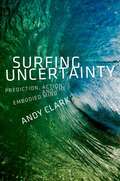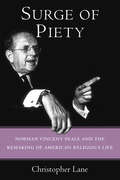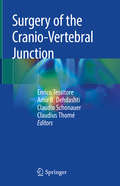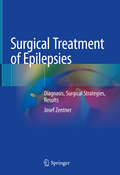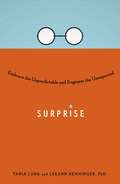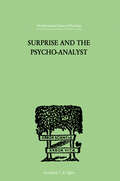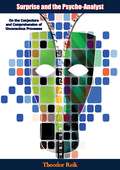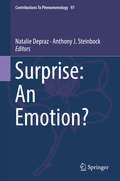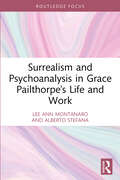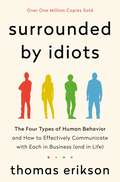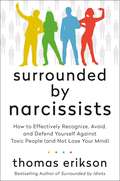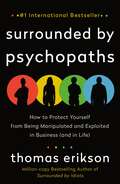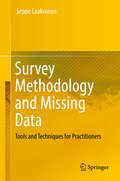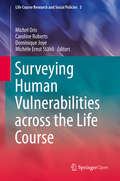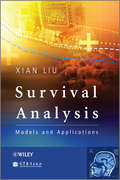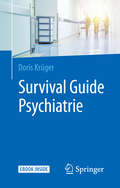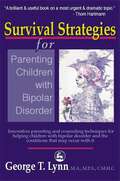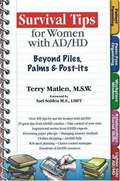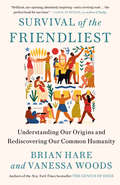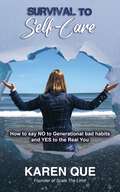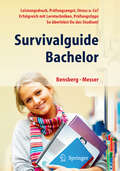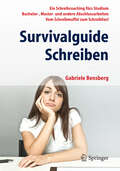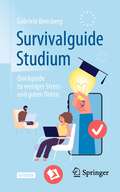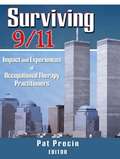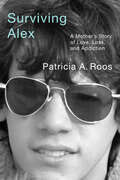- Table View
- List View
Surfing Uncertainty: Prediction Action and the Embodied Mind
by Andy Clarkn this groundbreaking work, philosopher and cognitive scientist Andy Clark explores exciting new theories from these fields that reveal minds like ours to be prediction machines - devices that have evolved to anticipate the incoming streams of sensory stimulation before they arrive. These predictions then initiate actions that structure our worlds and alter the very things we need to engage and predict. Clark takes us on a journey in discovering the circular causal flows and the self-structuring of the environment that define "the predictive brain." What emerges is a bold, new, cutting-edge vision that reveals the brain as our driving force in the daily surf through the waves of sensory stimulation.
Surge of Piety: Norman Vincent Peale and the Remaking of American Religious Life
by Christopher LaneThe dramatic untold story of how Norman Vincent Peale and a handful of conservative allies fueled the massive rise of religiosity in the United States during the 1950s Near the height of Cold War hysteria, when the threat of all-out nuclear war felt real and perilous, Presbyterian minister Norman Vincent Peale published The Power of Positive Thinking. Selling millions of copies worldwide, the book offered a gospel of self-assurance in an age of mass anxiety. Despite Peale's success and his ties to powerful conservatives such as Dwight D. Eisenhower, J. Edgar Hoover, and Joseph McCarthy, the full story of his movement has never been told. Christopher Lane shows how the famed minister's brand of Christian psychology inflamed the nation's religious revival by promoting the concept that belief in God was essential to the health and harmony of all Americans. We learn in vivid detail how Peale and his powerful supporters orchestrated major changes in a nation newly defined as living "under God. " This blurring of the lines between religion and medicine would reshape religion as we know it in the twentieth and twenty-first centuries.
Surgery of the Cranio-Vertebral Junction
by Enrico Tessitore Amir R. Dehdashti Claudio Schonauer Claudius ThoméThis book provides a unique tool for approaching cranio-vertebral junction (CVJ) surgery. Following a brief introduction to the relevant anatomy and biomechanics of CVJ, it explores the field of cranio-vertebral junction lesions and their management. Furthermore, individual chapters cover endovascular surgery, endoscopic skull base techniques, navigation and robotics, ensuring that surgeons stay up-to-date. A chapter addressing the consequences of CVJ surgery with regard to sagittal balance is of particular importance. The book is structured according both to the type of lesion involving the CVJ (tumor, trauma), and to the type of surgical approach (anterior, posterior). Further, it reflects innovative treatment modalities that have improved patient safety and efficacy rates for surgery involving the CVJ, and covers both open and minimally invasive surgical methods, enabling surgeons to hone their skills in both areas.
Surgical Treatment of Epilepsies: Diagnosis, Surgical Strategies, Results
by Josef ZentnerThis book fills the gap between the increasing demand for epilepsy surgical experience and limited training facilities in this area. It comprehensively describes surgical techniques, including tricks and pitfalls, based on the author’s 30 years of experience, providing optimal and effective training for young neurosurgeons by avoiding learning by trial and error. Moreover, it also includes useful information for epileptologists and other professionals involved in the epilepsy surgical program to allow them to gain a better understanding of possibilities and limitations of epilepsy surgery.
Surprise
by Leeann Renninger Tania LunaSurprise: Embrace the Unpredictable and Engineer the Unexpected is a fascinating look at how we can handle and harness surprise in our work, relationships, and everyday lives. Pop Quiz! Do you prefer when:A) Things go according to plan?B) When the unexpected happens? Most of us pick control and predictability. Yet research reveals a counterintuitive truth: surprise is the key that unlocks growth, innovation, and connection. It is also the secret ingredient in our best memories. Through colorful narratives and compelling scientific findings, authors Tania Luna and Dr. LeeAnn Renninger shine a light on the world's least understood and most intriguing emotion. They reveal how shifting our perception of surprise lets us thrive in the face of uncertainty. And they show us how surprise acts as a shortcut that turns a typical product into a meaningful experience, a good idea into a viral one, awkward small talk into engaging conversation, and daily life into an adventure.From the Hardcover edition.ng our perception of surprise lets us thrive in the face of uncertainty. And they show us how surprise acts as a shortcut that turns a typical product into a meaningful experience, a good idea into a viral one, awkward small talk into engaging conversation, and everyday life into an adventure.
Surprise And The Psycho-Analyst: On the Conjecture and Comprehension of Unconscious Processes
by Reik, TheodorFirst published in 1999. Routledge is an imprint of Taylor & Francis, an informa company.
Surprise and the Psycho-Analyst: On the Conjecture and Comprehension of Unconscious Processes
by Theodor ReikWritten in 1936, this book seeks to describe what is required of an investigator into the unconscious mental processes of another person, and what he achieves. By describing the psychological process of cognition from within, the author intends at the same time to trace the way from conjecturing to comprehending the unconscious processes.-Print ed.“The author describes his book as an attempt to set forth "What is required of an investigator into the unconscious mental processes of another person, and what he achieves." In fact the scope of the book is wider than this might suggest, for it makes a good many incursions into the fields of general psychological method and principle both normal and abnormal. Some of the topics dealt with are wit; tact, time and rhythm; memory and reminiscence; conjecture and comprehension; the ego mechanism; anticipation. The general thesis of the book is that when the true route of analysis and interpretation is followed there must be somewhere near the beginning always an experience of shock or surprise. This and its significance are fully discussed and illustrated by a mass of original observations.”-American Psychological Association.
Surprise: An Emotion? (Contributions To Phenomenology #97)
by Natalie Depraz Anthony J. SteinbockThis volume offers perspectives on the theme of surprise crossing philosophical, phenomenological, scientific, psycho-physiology, psychiatric, and linguistic boundaries. The main question it examines is whether surprise is an emotion. It uses two main theoretical frameworks to do so: psychology, in which surprise is commonly considered a primary emotion, and philosophy, in which surprise is related to passions as opposed to reason. The book explores whether these views on surprise are satisfying or sufficient. It looks at the extent to which surprise is also a cognitive phenomenon and primitively embedded in language, and the way in which surprise is connected to personhood, the interpersonal, and moral emotions. Many philosophers of different traditions, a number of experimental studies conducted over the last decades, recent works in linguistics, and ancestral wisdom testimonies refer to surprise as a crucial experience of both rupture and openness in bodily and inner life. However, surprise is a theme that has not been dealt with directly and systematically in philosophy, in the sciences, in linguistics, or in spiritual traditions. This volume accomplishes just that.
Surrealism and Psychoanalysis in Grace Pailthorpe's Life and Work
by Alberto Stefana Lee Ann MontanaroThis book outlines the life and intellectual thought of the English surrealist artist and psychoanalyst, Dr Grace Pailthorpe (1883–1971). It gathers her published and unpublished writings, providing an in-depth study of the importance of Surrealism in her work and legacy.Pailthorpe’s theoretical understanding of the psyche informed her approach to art, setting her work apart from other Surrealist artists by unifying artistic, scientific, and therapeutic aims. Pailthorpe considered Surrealism to be a method of investigation into unconscious mental life and believed that it was essential that the repressed part of our minds should find expression. Her theories were influenced by personal and professional experiences such as her work with female offenders, her psychoanalytic training, and her research project with Reuben Mednikoff. By bringing her artistic and theoretical work to light, Montanaro and Stefana reassert Pailthorpe’s significance to the histories of both psychoanalysis and Surrealism, rendering the cross-disciplinary relevance of her work accessible to a contemporary audience.This book is a rich resource for scholars and students interested in psychoanalysis and art history and provides an invaluable case study for the continuing significance of visual artistic practices to clinical work.
Surrounded by Idiots: The Four Types of Human Behavior and How to Effectively Communicate with Each in Business (and in Life) (The Surrounded by Idiots Series)
by Thomas EriksonDo you ever think you’re the only one making any sense? Or tried to reason with your partner with disastrous results? Do long, rambling answers drive you crazy? Or does your colleague’s abrasive manner rub you the wrong way? You are not alone. After a disastrous meeting with a highly successful entrepreneur, who was genuinely convinced he was ‘surrounded by idiots’, communication expert and bestselling author, Thomas Erikson dedicated himself to understanding how people function and why we often struggle to connect with certain types of people. Surrounded by Idiots is an international phenomenon, selling over 1.5 million copies worldwide. It offers a simple, yet ground-breaking method for assessing the personalities of people we communicate with – in and out of the office – based on four personality types (Red, Blue, Green and Yellow), and provides insights into how we can adjust the way we speak and share information. Erikson will help you understand yourself better, hone communication and social skills, handle conflict with confidence, improve dynamics with your boss and team, and get the best out of the people you deal with and manage. He also shares simple tricks on body language, improving written communication, advice on when to back away or when to push on, and when to speak up or shut up. Packed with ‘aha!’ and ‘oh no!’ moments, Surrounded by Idiots will help you understand and communicate with those around you, even people you currently think are beyond all comprehension. And with a bit of luck you can also be confident that the idiot out there isn’t you!
Surrounded by Narcissists: How to Effectively Recognize, Avoid, and Defend Yourself Against Toxic People (and Not Lose Your Mind) [The Surrounded by Idiots Series] (The Surrounded by Idiots Series)
by Thomas EriksonPart of the bestselling Surrounded by Idiots series!Internationally bestselling author Thomas Erikson shares the secrets of dealing with everyday narcissists.Are the narcissists in your life making you miserable? Are you worn out by their constant demands for attention, their absolute conviction they are right (even when they’re clearly not), their determination to do whatever they want (regardless of the impact), and their baffling need to control everyone and everything around them?In this thought-provoking, sanity-saving book, Thomas Erikson helps you understand what makes narcissists tick and, crucially, how to handle them without wearing yourself out in the process. With the help of the simple, four-color behavioral model made famous in Surrounded by Idiots, Erikson provides all the tools you need to manage not just the narcissists around you but everyday narcissistic behaviors as well–something that is becoming more widespread in the age of social media. Engaging and practical, Surrounded by Narcissists will help you free yourself from the thrall of others' toxic agendas so you can pursue a happier, more fulfilling and successful life.
Surrounded by Psychopaths: How to Protect Yourself from Being Manipulated and Exploited in Business (and in Life) (The Surrounded by Idiots Series)
by Thomas Erikson#1 internationally bestselling author Thomas Erikson shows readers how to identify and avoid the psychopaths around them.Charming, charismatic, and delightful or manipulative, self-serving, and cunning? Psychopaths are both and that’s exactly what makes them dangerous. Bestselling author of the international phenomenon Surrounded by Idiots, Thomas Erikson reveals how to identify the psychopaths in your life and combat their efforts to control and manipulate. Using the same simple four-color system of behavior classification that made Surrounded by Idiots so popular, Surrounded by Psychopaths teaches readers how to deal with psychopaths in their lives by becoming aware of their own behavior and their weaknesses. Vivid example stories illustrate ways that psychopaths can take advantage of various behavior types, helping readers identify their own weaknesses and be proactive about protecting themselves. Erikson outlines some of the most common forms of manipulation used by psychopaths—and others—to influence those around them. Since manipulation can often be a feature of ordinary, non-psychopathic relationships, the book also includes practical methods and techniques to help readers confront controlling people and rehabilitate negative relationships into mutually respectful ones. By understanding your behavior as well as the tendencies and strategies of psychopaths, Surrounded by Psychopaths will teach you to protect yourself from manipulative influence in your workplace, social life, and family.
Survey Methodology and Missing Data: Tools and Techniques for Practitioners
by Seppo LaaksonenThis book focuses on quantitative survey methodology, data collection and cleaning methods. Providing starting tools for using and analyzing a file once a survey has been conducted, it addresses fields as diverse as advanced weighting, editing, and imputation, which are not well-covered in corresponding survey books. Moreover, it presents numerous empirical examples from the author's extensive research experience, particularly real data sets from multinational surveys.
Surveying Human Vulnerabilities across the Life Course (Life Course Research And Social Policies Ser. #3)
by Caroline Roberts Michel Oris Dominique Joye Michèle Ernst StähliThis volume details tools and procedures for data collections of hard-to-reach, hard-to-survey populations. Inside, readers will discover first-hand insights from experts who share their successes as well as their failures in their attempts to identify and measure human vulnerabilities across the life course. Coverage first provides an introduction on studying vulnerabilities based on the Total Error Survey framework. Next, the authors present concrete examples on how to survey such populations as the elderly, migrants, widows and widowers, couples facing breast cancer, employees and job seekers, displaced workers, and teenagers during their transition to adulthood. In addition, one essay discusses the rationale for the use of life history calendars in studying social and psychological vulnerability while another records the difficulty the authors faced when trying to set-up an online social network to collect relevant data. Overall, this book demonstrates the importance to have, from the very beginning, a dialogue between specialists of survey methods and the researchers working on social dynamics across the life span. It will serve as an indispensable resource for social scientists interested in gathering and analyzing data on vulnerable individuals and populations in order to construct longitudinal data bases and properly target social policies.
Survival Analysis
by Xian LiuSurvival analysis concerns sequential occurrences of events governed by probabilistic laws. Recent decades have witnessed many applications of survival analysis in various disciplines. This book introduces both classic survival models and theories along with newly developed techniques. Readers will learn how to perform analysis of survival data by following numerous empirical illustrations in SAS.Survival Analysis: Models and Applications: Presents basic techniques before leading onto some of the most advanced topics in survival analysis.Assumes only a minimal knowledge of SAS whilst enabling more experienced users to learn new techniques of data input and manipulation.Provides numerous examples of SAS code to illustrate each of the methods, along with step-by-step instructions to perform each technique.Highlights the strengths and limitations of each technique covered.Covering a wide scope of survival techniques and methods, from the introductory to the advanced, this book can be used as a useful reference book for planners, researchers, and professors who are working in settings involving various lifetime events. Scientists interested in survival analysis should find it a useful guidebook for the incorporation of survival data and methods into their projects.
Survival Guide Psychiatrie
by Doris KrügerDas Buch führt praxisorientiert und konsequent den Assistenzart durch die Hindernisse im ersten Jahr der Psychiatrie. Es beantwortet zahlreiche organisatorische Fragen und ist der Rote Faden, der Anfängern zu Beginn ihrer Berufszeit die Unsicherheit nehmen soll.
Survival Strategies for Parenting Children with Bipolar Disorder: Innovative Parenting and Counseling Techniques for Helping Children with Bipolar Disorder and the Conditions That May Occur With It
by George Lynn'A definitve guide covering all aspects of Bipolar in children, from spotting the symptoms to getting the correct interventions to help cope with the condition. This book explains the Biological causes and helps to seperate the symptoms from those of other conditions including, Tourettes, Aspergers and ADHD, whilst acknowledging that the conditions can appear as co-morbid in some children. Full of practical help and support George Lynn discusses various case histories and how to cope as a parent, along with a guide to help the child learn strategies to live with Bipolar.' - adders.org 'The author, George Lynn, is a certified medical health counselor who has pioneered the usage of psychotherapy for adults and children with neuropsychological issues. When his own son was diagnosed with Tourette syndrome in 1991, he realized that personality can be powerfully impacted by brain chemistry independent of environment...The book is orientated for parents, but I believe many professionals can find helpful tips and information.' - International Journal of Adolescent Medical Health 'George T. Lynn's book, Survival Strategies for Parenting Children with Bipolar Disorder is a valuable resource for parents and those in the mental health profession. The author draws on his experience as a counselor to describe the symptoms of Bipolar Disorder and Bipolar Disorder co-existing with Asperger's Syndrome, Tourette's Disorder or ADHD. He provides a clear, comprehensive perspective on effectively parenting a child with bipolar disorder. He also explains what characteristics the disorders have in common and how they differ from each other. Lynn is skilled at developing the differential diagnosis of disorders that often have significant overlapping characteristics. In every chapter Lynn provides a comprehensive case history, parent survival strategies and simple, straightforward tips for 'surviving meltdowns.' He includes a section on brain physiology, medication management and school success. He gives practical advice about difficult decisions that parents often have to make, including when to call the police and the pros and cons of psychiatric hospitalization. With this book, George Lynn has made a major contribution in the area of parenting children with Bipolar Disorder. He successfully instructs the reader on how to understand and identify the symptoms of these disorders and at the same time how to focus on the child's strengths or "gifts". He delivers a well written and interesting book that provides realistic solutions to difficult problems, and hope to families of these exceptional children.' - Metapsychology Online Review Up until five years ago, the professional community did not think that Bipolar Disorder occurred in children. Children with symptoms of Bipolar Disorder were diagnosed as 'severe ADHD', 'depressed' or 'Oppositional Defiant'. Now, as it is being increasingly diagnosed, George Lynn offers clear, practical advice on recognizing the symptoms, understanding medication and accessing the necessary support at school as well as the managing the day-to-day challenges of parenting a child with Bipolar Disorder. As it is frequently found in combination with ADHD, Tourette Syndrome and Asperger's Syndrome, the author draws on case-studies from his own psychotherapeutic practice to show what these conditions have in common, how they differ, and how they relate to each other. Survival Strategies for Parenting Children with Bipolar Disorder, tackles the most difficult decisions parents can face, including whether to involve police or consider hospitalization if their children are a danger to themselves and their families. At the same time, it emphasizes the positive qualities these children often have and illustrates how their gifts and abilities can build their self-esteem and help them function better in society. However severe the child's symptoms, George Lynn's book will provide guidance, support and inspiration for parents and carers as well as being a useful resource for professionals working with the families who ...
Survival Tips For Women With AD/HD: Beyond Piles, Palms And Post-its
by Terry MatlenWomen with AD/HD tormented by the daily chores and decisions needed to survive in a world of linear thinking will find solace in this self-help guide. Practical tips provide help in dealing with organizational tasks, including paperwork in the home and office, preparing meals, social situations, paying bills on time, household chores, shopping, and personal and family health.
Survival of the Friendliest: Understanding Our Origins and Rediscovering Our Common Humanity
by Brian Hare Vanessa WoodsA powerful new theory of human nature suggests that our secret to success as a species is our unique friendliness&“Brilliant, eye-opening, and absolutely inspiring—and a riveting read. Hare and Woods have written the perfect book for our time.&”—Cass R. Sunstein, author of How Change Happens and co-author of Nudge For most of the approximately 300,000 years that Homo sapiens have existed, we have shared the planet with at least four other types of humans. All of these were smart, strong, and inventive. But around 50,000 years ago, Homo sapiens made a cognitive leap that gave us an edge over other species. What happened? Since Charles Darwin wrote about &“evolutionary fitness,&” the idea of fitness has been confused with physical strength, tactical brilliance, and aggression. In fact, what made us evolutionarily fit was a remarkable kind of friendliness, a virtuosic ability to coordinate and communicate with others that allowed us to achieve all the cultural and technical marvels in human history. Advancing what they call the &“self-domestication theory,&” Brian Hare, professor in the department of evolutionary anthropology and the Center for Cognitive Neuroscience at Duke University and his wife, Vanessa Woods, a research scientist and award-winning journalist, shed light on the mysterious leap in human cognition that allowed Homo sapiens to thrive. But this gift for friendliness came at a cost. Just as a mother bear is most dangerous around her cubs, we are at our most dangerous when someone we love is threatened by an &“outsider.&” The threatening outsider is demoted to sub-human, fair game for our worst instincts. Hare&’s groundbreaking research, developed in close coordination with Richard Wrangham and Michael Tomasello, giants in the field of cognitive evolution, reveals that the same traits that make us the most tolerant species on the planet also make us the cruelest. Survival of the Friendliest offers us a new way to look at our cultural as well as cognitive evolution and sends a clear message: In order to survive and even to flourish, we need to expand our definition of who belongs.
Survival to Self-Care - How to say NO to generational bad habits and YES to the real you
by Karen QueSurvival to Self-Care: How to say NO to generational bad habits and YES to the real you is a story based self-help book which brings to light generational cycles and presents a seven-step process to stop passing them on to future generations. Karen Que explores how life has a way of piling on unfulfilled expectations. These help to build up varying levels of emotional armor, requiring new skills for survival. At the height of her career, feeling buried in pain at her lowest moment, she dug her way out by discovering how to identify, unpack, and release cycles which were handed down through the generations. Each purchase of Survival to Self-Care comes with a special BONUS Companion E-Journal featuring 20 pages to help you accelerate your transformation with exercises and additional tools for better self-care.
Survivalguide Bachelor. Leistungsdruck, Prüfungsangst, Stress und Co? Erfolgreich mit Lerntechniken, Prüfungstipps ... so überlebst Du das Studium
by Gabriele Bensberg Jürgen MesserDurch das Bachelor-Studium hat sich das Studieren verändert. Häufige Prüfungen und überfrachtete Studienpläne setzen Studierende unter Druck, die Prüfungsangst nimmt zu. Die Autoren leiten eine Beratungsstelle des Studentenwerks, sie kennen diese Nöte. In ihrem Ratgeber zeigen sie auf einfühlsame und humorvolle Weise, wie sich Studierende physisch und psychisch stärken können: durch Bewegung, Entspannungstechniken und Genuss. Sie vermitteln Strategien für effektives Lernen, für das Stressmanagement sowie Hilfen zur Bewältigung der Prüfungsangst.
Survivalguide Schreiben: Ein Schreibcoaching fürs Studium Bachelor-, Master- und andere Abschlussarbeiten Vom Schreibmuffel zum Schreibfan!
by Gabriele BensbergWenn Studierenden das Schreiben wissenschaftlicher Texte schwer fällt, kann es für sie zum Fluch werden - bis hin zur Angst, an der Abschlussarbeit zu scheitern. Die Autorin, erfahrene Studierenden-Beraterin und Schreibcoach, zeigt in diesem Buch, wie Studierende aufbauend auf ihren alltäglichen Schreibaktivitäten im Internet eine Brücke zum wissenschaftlichen Schreiben schlagen können. Das Buch bietet Handlungsanleitungen und Problemlösungen für alle Phasen der wissenschaftlichen Arbeit und dient darüber hinaus als psychologischer Begleiter.
Survivalguide Studium: Quickguide zu weniger Stress und guten Noten
by Gabriele BensbergStudieren hat es in sich heutzutage - nicht erst seit Beginn der Corona-Pandemie! Doch hier kommt ein kleines Buch, das Dir auf wenigen Seiten den Weg durch den Studi-Alltagsdschungel zeigt. Es gibt viele handliche Tipps rund um Themen wie Arbeitsplatz, Zeitmanagement, Lernmethoden, Möglichkeiten, die Gedächtnisleistung zu steigern sowie die Vorbereitung von Prüfungen und das Schreiben wissenschaftlicher Arbeiten. - Du leidest unter Prüfungsangst oder Schreibblockaden? Lass Dich nicht entmutigen - denn auch das ist lösbar, dieser Ratgeber sagt Dir, wie! Und nicht zuletzt hat er noch hilfreiche Tipps parat, wie Du ganz allgemein eine individuelle Lebensvision entwickelst, Dir Ziele setzt und Selbstvertrauen gewinnst, um Deinen eigenen Weg zu finden und diesen auch bei Widerständen zu gehen - denn wer sich über all dies im Klaren ist, den werfen die Probleme des Studienalltags auch nicht so schnell aus der Bahn. Kurz: Dies ist Dein Guide für den tollen Lebensabschnitt, der sich Studium nennt!
Surviving 9/11: Impact and Experiences of Occupational Therapy Practitioners
by Pat PrecinThe first in-depth look of the effects of September 11 on occupational therapy! Surviving 9/11: Impact and Experiences of Occupational Therapy Practitioners is a collection of firsthand accounts from occupational therapy providers and their clients. This book reveals the thoughts and fears of occupational therapists who had to help heal their patients while suffering emotional and psychological stress themselves. This volume shows how occupational therapy practitioners dealt with the aftermath using group discussions, planned events, and creative projects to heal themselves as well as their clients. Surviving 9/11 demonstrates the importance of therapeutic treatment for all types of victims of the attacks, from survivors to television observers. It discusses how distinct each client&’s needs are-from the survivor in the hospital bed to the firefighter endlessly searching for his lost brothers. This book will also show you the importance of changing therapeutic styles during the lengthy coping process to adapt to the changing needs of the client. This enlightening text is divided into three parts: September 11th Day One-personal and professional accounts of the day of the disaster from occupational therapists in and around the city and around the world-with a special narrative from a 9/11 survivor who received occupational therapy Ground Zero Milieu-the experiences in and around Ground Zero following the attack, including occupational therapists at the rescue and recovery site, the Federal Emergency Management Agency&’s (FEMA) Project Liberty program, and the development of the Downtown Therapists Assistance Project to help occupational and physical therapists whose businesses were irrecoverable after September 11 Spirituality-the new challenges to occupational therapy in mental health in dealing with post-traumatic stress disorder and panic disorder-throughout the general population and in the mental health community Surviving 9/11 is a unique blend of personal and professional perspectives designed to help you get in touch with your feelings and thoughts about what happened on September 11. More importantly, this easy-to-read book can help you prepare for future disasters, whether you are a healthcare professional, a disabled person, a survivor, or someone who is otherwise affected. With illustrations, memorial designs, and photos of the tragedy and its aftermath, this book is a must-read in this age of uncertainty.
Surviving Alex: A Mother’s Story of Love, Loss, and Addiction
by Patricia A. RoosIn 2015, Patricia Roos’s twenty-five-year-old son Alex died of a heroin overdose. Turning her grief into action, Roos, a professor of sociology at Rutgers University, began to research the social factors and institutional failures that contributed to his death. Surviving Alex tells her moving story—and outlines the possibilities of a more compassionate and effective approach to addiction treatment. Weaving together a personal narrative and a sociological perspective, Surviving Alex movingly describes how even children from “good families” fall prey to addiction, and recounts the hellish toll it takes on families. Drawing from interviews with Alex’s friends, family members, therapists, teachers, and police officers—as well as files from his stays in hospitals, rehab facilities, and jails—Roos paints a compelling portrait of a young man whose life veered between happiness, anxiety, success, and despair. And as she explores how a punitive system failed her son, she calls for a community of action that would improve care for substance users and reduce addiction, realigning public health policy to address the overdose crisis.
